6 Content Marketing Tips for 2020


When marketers sit together, they generally talk about marketing as it is on their minds continuously.
Recently, at New Year's gathering, a bunch of my friends had a discussion on marketing trends in 2020.
I raised a discussion on how content marketing is changing and where it is heading this year.
As I love to blog, I decided to share my thoughts in writing.
In this post, I'll give you some tips to create amazing content to help increase your audience this year.
Let's dive right in.
Implement a Content First Approach
A Content First approach allows marketers to store and monetize their content without the need of a developer having to write any code. Using this approach in 2020 will give marketers and editors ultimate freedom.
Implementing Content First approach starts with switching to a Headless CMS. When you separate your content hub ("body") from its presentation layer - website ("head") it becomes a headless CMS.
What really makes a headless CMS better than a traditional CMS (like WordPress or Wix) is that it changes your mindset and forces you to focus on the goals and structure of your content first. Hence, "content-first".
Using this approach, a headless CMS enables you to distribute your content via the RESTful API, and you can deliver that content wherever you need it. Not just websites, but mobile apps, social media, digital displays - whenever your digital strategy takes you!
That being said, when choosing headless CMSs, do not get tempted by those who only promise to handle your content. Look for the ones that allow you also to manage your website, because, at the end of the day, you need to quickly and effortlessly manage your main content destination – your website!
It is explained here:
Usage of Videos
People might not watch a video with the intention of buying, but they will play a video to know what's in it. Engaging videos play a huge role in increasing your brand awareness.
According to a survey, 55% of shoppers said they used videos during shopping to decide which specific brand or product they want to purchase.
In 2020, make videos a part of your content marketing strategy. You can make How to, personal, DIY style, informative, animated, text-based videos for your brand or website using an online video editor. The type of video depends on your audience.
Use of Long Tail Keywords
The world is now moving towards personalized and screen-less online searches.
According to Gartner, about 30% of online searches take place by voice search. And this is where deciding to create content around long-tail keywords is ideal.
They are not common, so few websites compete for them. Therefore, it is easier to rank these keywords in search engines.
Many people tend to target Medium or short-tail keywords as they may have a higher search volume. What they don't realize is you need to do a lot of promotion to rank for these keywords.
The longer the keyword, the more specific it is, and also, the easier to achieve a higher ranking.
Most people are specific about what they search for in Google. For example, if you want to search for "Nike shoes in red color," you are likely to add the color to get straight to what you were initially looking for.
Short Tail keyword: Shoes
Medium Tail keyword: Red shoes
Long-tail keywords:
- Red Nike shoes
- Red Nike man shoes
- Nike shops in California with red shoes
- Shoelace alternatives
By optimizing your content around long-tail keywords, it stands a higher chance to rank on top of search results.
Easy to Read and Engaging Content
Remember, no one likes to read ambiguous and complicated stuff. You have to create content that is relatable and easy to read. It is crucial for your readers, SEO, and Google.
If it takes effort to understand your content, you will be losing your audience. In the long run, it also controls how well or poor your content will perform in the search results.
In addition to readability, the content needs to be engaging. According to content marketing experts like Brian Dean and Neil Patel, you should avoid writing more than three sentences without a line break. No one enjoys reading long paragraphs online.
Moreover, use simple language that is clear and easy to understand.
Use High-Quality Relevant Images
Adding visuals to your content is essential. According to a survey, 88% of marketers use visuals for creating engaging content.
Adding fascinating visual elements to your content is always a plus. You can not only add images but also create infographics that are proven to generate more traffic.
There are many websites where you can find high-quality images, and you can also customize them according to your content.
Personalization
Personalization undoubtedly is the foundation for engaging content.
Every point I have mentioned talks about personalization, whether it is about long-tail keywords, easy to read content, use of images, or videos.
Let's face it; no one wants to read long blogs that fail to establish a connection with their readers.
According to the business influencer Dan Lok, people don't buy because of logic. People buy because of emotions, which they justify with logic.
The same goes for content. People are unlikely to read content that may not be relatable.
Personalization is getting bigger and better with time. It's not just about creating personalized content; it's about having a relatable conversation with your audience.
Within a short time, you have to grab the attention of your readers. The best way to create personalized content is by putting yourself in your audience's shoes. You have to understand why the audience would want to read your blog or watch that video. Sometimes, this is also referred to as hyper-personalization and you can read more about it in this guide by Ikaros.
When you know the answer to the "why" part, it will be easy to figure out the "how." The benefits and use cases of personalization are numerous.
Conclusion
To sum it up, content marketing is certainly one of the most potent marketing strategies as it increases the engagement of your brand.
According to the Content Marketing Institute, 91% of B2B marketing professionals reach their consumers using content marketing. And with the availability of various blogging platforms, it shows no signs of slowing down.
Besides creating fantastic content, don't forget to update your old content and fix any broken links. They negatively affect user experience and are bad for SEO. In case you have had old content relocated or removed, you must have proper redirects in place.
To sum it up, for effective content marketing campaigns in 2020, you must keep these tips in your mind:
- Implement the content-first approach
- Use long-tailed keywords
- Create relatable content, tell a story
- Use visuals for captivating your viewer or readers' attention
- Try to Make videos a part of your content marketing strategy
- Create content that is easy to understand
Innovation is the key, and you shouldn't fear taking risks and trying out something new.

About the Author
Amos Struck is a veteran stock media industry expert with numerous achievements under his belt: he is the founder of Stock Photo Press, he is involved in the development of several WordPress plugins and products for stock photo buyers, and he is also co-founder of Microstock Expo, the first conference event specialised in the microstock segment. Amos has a strong business background and applies his over a decade of industry experience, insider knowledge and expert insights to help you understand it all about microstock and stock photography. Plus, he has excellent relationships with the major agencies in the field and works with them to bring you exclusive discounts and deals.
